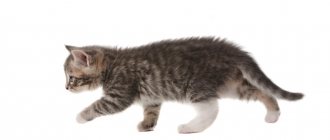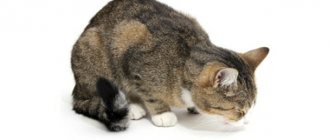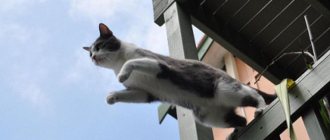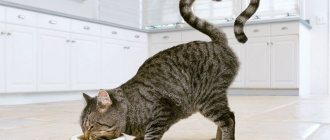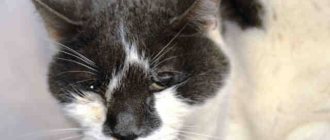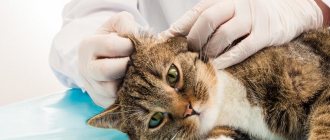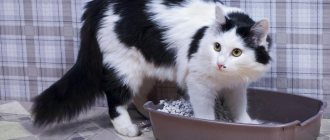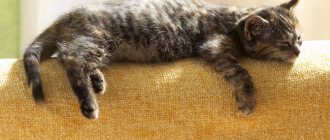There are a lot of people in the world who feel sorry for and warm animals, including homeless and defenseless ones. It happens that kittens are simply found, but they no longer have a mother cat. Then the care of the foundlings falls on the shoulders of those who want to help.
How to get a kitten to go to the toilet? In the first three weeks of life, kittens cannot take care of themselves. Then the act of defecation and urination is carried out only with active stimulation of the corresponding zones. Typically, the mother cat carefully licks the kittens under the tail, thereby causing emptying of the bladder and rectum. It is somewhat more difficult for a person to organize the process, especially if he has no experience in caring for kittens.
Recommendations
How to get a kitten to go to the toilet? After feeding, carefully and at the same time firmly fix the pet so that it cannot slip out. The fingers of the hand should be located simultaneously under the chest and stomach, so that the tail is towards the caregiver. You need to put a damp, warm napkin on your other hand, preferably white, but you can also use light colors, because it’s easier to tell on a light fabric whether the kitten went to the toilet or not.
Next, you need to stimulate the baby to urinate. Do not apply strong pressure and wipe the area from the lower abdomen to the anus. If the kitten went to the toilet (did not defecate - wiping continues), then you need to move to the anal area, doing a specific massage. Usually the effect occurs within a minute. But it happens that animals cannot go even after several feedings. Then you need to show him to a veterinarian.
After the job is done, you must first wipe the contaminated areas of the skin with a clean edge of the napkin (urine and feces are irritating, and dermatitis or a genitourinary tract infection may develop at the site of their appearance, since there is no strong immunity yet formed). It is also necessary to dry wet areas. This procedure is done for each kitten.
If there are several children, separate napkins are allocated for each of them (these can be pieces of bandage, gauze, cotton pads, which are thrown away after use). The whole procedure must take place in a warm room without drafts, otherwise the baby will become hypothermic and die.
Self-diagnosis
If the owner suspects problems in the functioning of the urinary system of his beloved pet, he should provide him with first aid. If it is not possible to consult a veterinarian, then you should examine the animal yourself at home to determine the degree of fullness of the bladder.
To do this, place your furry pet on its paws and clasp it with both hands. After this, carefully palpate the bladder, which is located on a line perpendicular to the testes. In case of severe inflammation, the cat will not allow you to do this, and this is a clear signal that it urgently needs to be taken to the clinic.
We invite you to read: Pneumothorax in Dogs, Cats and Other Animals (Symptoms and Treatment) || Pneumothorax in a cat
If you do manage to examine the bubble, try to estimate its size and also determine how dense it is. A healthy cat's bladder is soft to the touch and the size of a nut.
A hard or enlarged bladder indicates the development of serious problems, so take your pet to a doctor right away. To alleviate the cat's severe condition, try placing a heating pad on her perineum and stomach.
Important: some pet owners think that if dangerous symptoms appear, they should help the suffering pet by massaging the cat’s belly. But in fact, such actions can only worsen the problem.
Cases of constipation in kittens per month of life
The causes of constipation are varied, but most often occur due to improper feeding, since the stomach does not yet accept too solid food (it is accustomed to breast milk or formula), the presence of infestation or hair in the stomach (long-haired cats suffer more often).
It is easy to detect: the baby does not go to the toilet for more than two days, the tummy begins to increase in size, the animal is worried and meows pitifully, the kitten can squat into a defecation position, but nothing comes out (the discharge can be the size of a bean seed).
Special diet
Regardless of the diagnosis, a sick cat will need a corrective diet. It is necessary to exclude from the animal’s diet foods that irritate the kidneys and organs of the urinary system.
Cheap dry food of the “economy” and “premium” classes is prohibited. These products contain a lot of salt, preservatives, flavors and dyes. Of the expensive dry food, only special brands designed for animals with urological diseases and urolithiasis are allowed.
Foods that should not be given to sick cats:
- Pork is a fatty meat that thickens urine.
- Milk is a source of magnesium, which obstructs the flow of urine.
- Salt.
- Raw fish contains phosphorus. May cause the formation of stones in the bladder.
- Raw meat. Protein foods overload the kidneys.
Until the animal’s condition stabilizes, the cat’s diet should be light, high-calorie and natural. It is imperative to ensure compliance with the drinking regime - the cat should always have a sufficient amount of fresh drinking water.
Ways to help a kitten get things done
How to help a kitten go to the toilet? You can use enemas, the most effective are Microlax for children from zero years of age (after insertion, the anus must be closed with the tail, otherwise the microenemas will be of no use, and wait a little). In addition to the enema, massage the tummy in a clockwise circular motion. If feces appear from the anus, but cannot come out on their own, you need to begin to quietly and very carefully push it out. The kitten needs to be shown to a veterinarian not only if he was unable to go, but also for preventive purposes.
Outdoor toilet
How to train a kitten to go to the toilet in a private house? There are two methods to teach your baby to go to the toilet outside using a tray. The first is the gradual development of a habit. The second is the most common, but you need to monitor the animal’s reaction. If the baby looks for a dark corner after feeding, he tries to show that he wants to go to the toilet, in which case he needs to be taken outside. The actions must be repeated so that he can get used to doing his business near the house.
How to make a kitten go to the toilet if he is hiding? Close the doors before feeding, then he will be in sight. You can walk the cat after each feeding and wait for the result. This will have a good effect on digestion. Within a few days, you will develop the reflex to ask to go outside.
Preventive actions
To prevent problems with bowel movements, several requirements must be observed:
- provide the cat with enough water;
- introduce the required amount of fiber into the diet;
- get rid of problems with the intestines and urinary system in a timely manner;
- vaccinate your pet and protect it from worms;
- prevent physical inactivity, often play with the cat, take it for a walk.
In addition, you need to monitor the pet’s condition. If even minor symptoms of the disease appear, you should seek help from a veterinary hospital.
Toilet in the apartment
How to train a kitten to use the toilet in an apartment? Not all owners have the opportunity to take their pet outside after each feeding, especially since in the courtyard of a multi-story building there are many hidden dangers, ranging from physical injuries to infectious and invasive diseases. Therefore, it is advisable to accustom the kitten to the toilet in the apartment. To develop a strong habit, you need to take your baby to the place where the tray will be or is already located. When choosing a place for a cat's litter box, you need to take into account several nuances: cats do not like to be looked at during such a delicate task, the tray should be easy to get from this place.
Kitten training
How to get a kitten to go to the toilet if the previous owners did not teach him to go to the litter box? The main thing is not to get upset. During the day, you should watch your pet and take it to the place where the tray should be located. If the pet made a puddle or something else: for example, a person went into another room for literally half a minute or absent-mindedly missed the moment - then it is imperative to immediately clean up after the baby and clean the area with a strong-smelling detergent (if this is not done, the wrong habit may form) . Cats use their scent to navigate where to go to the toilet, and the kitten will return to this place again and again, rather than go to the litter box.
Selecting a location
How to train a kitten to use a litter tray? If you are just planning to take a baby, then you need to immediately approach the responsible task correctly. The first purchase for a kitten, of course, is a tray, which it is advisable to choose correctly.
Let's look at some types:
- The cheapest option is a plastic tray with low sides. It washes well and takes up little space, but a significant drawback is that it is used together with filler granules, which the kitten can scatter or eat (you need to think about eating in advance).
- Tray with mesh. Can be used without filler. It has high sides. Cats like these because they look like boxes.
- Tray in the form of a house (closed type). The advantage of such a device is its aesthetics, the disadvantage is the high cost of the device.
- Self-cleaning tray. This option has a number of positive qualities: the cleanliness of the tray does not require the owner’s attention; no odor; Four pets can go into this tray; presence of a motion sensor; safety of capsules. The negative aspects are: connection to water supply and electricity, noisy flushing, which can frighten the animal.
How to help a kitten?
How to get a kitten to go to the toilet? If the kitten is already familiar with the place where he needs to go to the toilet, but is not yet used to it, you need to wait until the baby fusses or starts digging. Then it is necessary to urgently carry it into the tray and not release it until the desired effect is achieved. The animal will monitor the reaction of the owner or mistress. You can praise him and pet him. There is no need to remove the contents of the tray right away: the baby will get used to it and remember the place faster. The main thing is not to use cruelty as punishment (deprive the kitten of water or food, leave it alone in the room, beat or push the kitten).
You need patience and perseverance - then the kitten will be everyone’s favorite, devoted to you for the rest of its life.
Urgent medical care
First aid in a veterinary clinic involves inserting a catheter. Only a professional should insert a catheter, after first flushing the bladder with antiseptics. This operation is painful, so it is performed under general anesthesia. After catheterization, the veterinarian performs a series of tests to find the cause of urinary retention.
Important: you should not insert a catheter often - after this procedure, swelling of the urinary tract occurs. If the doctor sewed in a catheter for several days, you need to keep the cat in a special collar during this time so that it does not injure itself and does not remove the catheter.
In the most difficult cases, surgery and the use of a catheter will be required to remove fluid from the cat's body. This procedure is quite painful, so it can only be performed by a qualified specialist. In some cases, such operations are performed using general anesthesia.
In most cases, painkillers are used and tinctures of medicinal herbs are given. Here are some of the herbs whose decoctions are recommended to be used in this case: rose hips, lavender, lingonberries, plantain, horsetail.
They often prescribe one teaspoon of strawberry juice, boiled pumpkin, and a hot bath for ten minutes (the cat is carefully lowered into the water up to the heart area).
In cases where all kinds of inflammatory processes appear, the pet needs to take medications that relieve inflammation. At the same time, it is very important to complete the full course of treatment, and not stop it at the first signs of improvement in the cat’s condition.
It is necessary to include vitamin complexes in your daily diet, and add nettles to your food in the spring months. Walks and active games have a positive effect on the cat's condition.
Most diseases of the urinary system are chronic, so it is recommended to repeat the course of treatment constantly, as well as taking herbs and decoctions based on it.
We invite you to read: Why cats leave home to die: the main reasons that force pets to leave a safe shelter, signs of imminent death
Important: kidney collection is an excellent means for removing sand from an animal’s body. You can buy it at the pharmacy, but before doing so, consult a specialist. You can constantly give your cat water with decoctions of parsley, birch leaves, black currants and bearberry. The course of treatment in this case should last at least a month.

